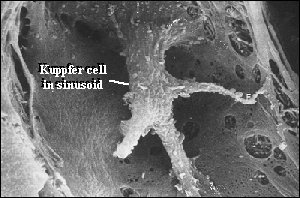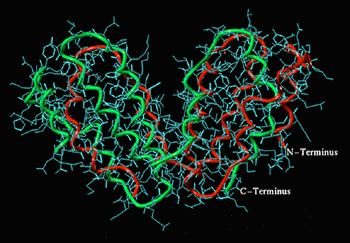*This web page was produced as an assignment for an undergraduate course at Davidson College.*
Innate Immune Response
Cytokine secretion and natural killer (NK) cell activation typically characterize the body’s innate immune response to viruses. Cytokines are produced as a result of toll-like receptor (TLR) signaling pathways, which recognize pathogen associated molecular patterns (PAMPs). A similar innate immune response occurs in HBV.
Unlike most viruses, HBV does not begin replicating immediately. Instead, there is an initial lag phase, which typically lasts for 4-7 weeks after infection. The lag phase is followed by a logarithmic expansion phase that infects most hepatocytes. Studies performed on chimpanzees infected with HBV demonstrate that no genes were activated during the lag phase, indicating that no innate immune response occurred during initial infection of HBV (Bertoletti and Gehring, 2006). However, the onset of the logarithmic expansion phase triggers the infected hepatocytes to release IFN-alpha/beta. IFN-alpha/beta are cytokines that are known to reduce the amount of viral capsids encoding HBV pregenomic RNA and to stimulate double-stranded dependent kinas activity (PKR), both of which inhibit the synthesis of HBV proteins. IFN-alpha/beta also activates antigen presenting cells (APCs), which include Kupffer cells and dendritic cells. As a result, the activated APCs stimulate the production of interleukin-18 (IL-18) and the chemokine CCL3, which in turn trigger NK and natural killer T (NKT) cell activity (Chang and Lewin, 2007). The figure below shows an image of a Kuppfer cell in the sinusoid.

Figure 5. Image from http://z.about.com/d/biology/1/0/G/3/kupffer_sem.jpg
NKT cells secrete another cytokine, known as IFN-gamma. IFN-gamma is one of the most important mediators in the immune system and is associated with inhibition of viral replication (Huang et. al., 2006). In HBV transgenic mice, NKT cells, which were stimulated with an a-galactosylceramide injection, demonstrated the direct inhibition of HBV replication without the activation of CD4+ or CD8+ T cell activity. As a result, it appears that the innate immune system has the capacity to monitor viral replication without the aid of the adaptive immune system. However, during the natural course of infection, the adaptive immune response is activated to rid the host of the virus (Kakimi et. al., 2000). The figure below depicts an image of IFN-gamma.

Figure 6. Image from http://www.igb.fraunhofer.de/www/gf/Pharma/bilder/IFN-g-dimer_os_350.gif
Chang, J. & Lewin, S. 2007. Immunopathogenesis of hepatitis B virus infection. Immunology and Cell Biology 85:16-23.
Huang, C., Lin, S., Ho, Y., Chen, F., & Yang, C. 2006. The immune response induced by hepatitis B virus principal antigens. Cellular and Molecular Immunology 3(2): 97-106.
Kakimi, K., Guidotti, L., Koezuka, Y., & Chisari, F. 2000. Natural killer T cell activation inhibits hepatitis B virus replication in vivo. Journal of Experimental Medicine 192(7): 921-930.
Return to Christie's Immunology Home Page
Christie Brough. Biology 307: Immunology. Dr. S. Sarafova. Davidson College. May 4, 2007.